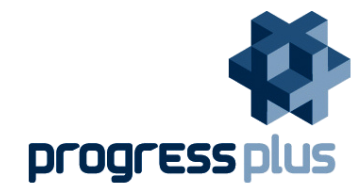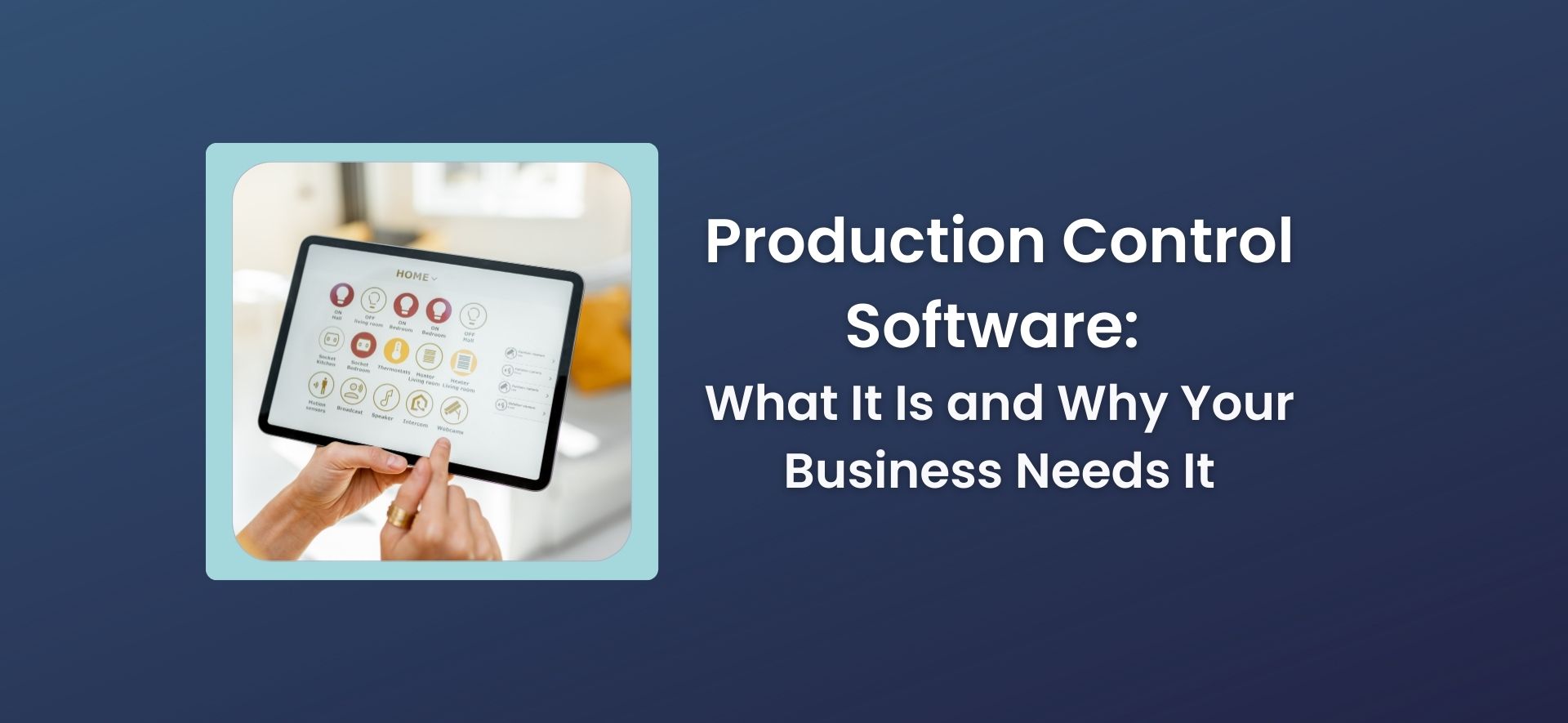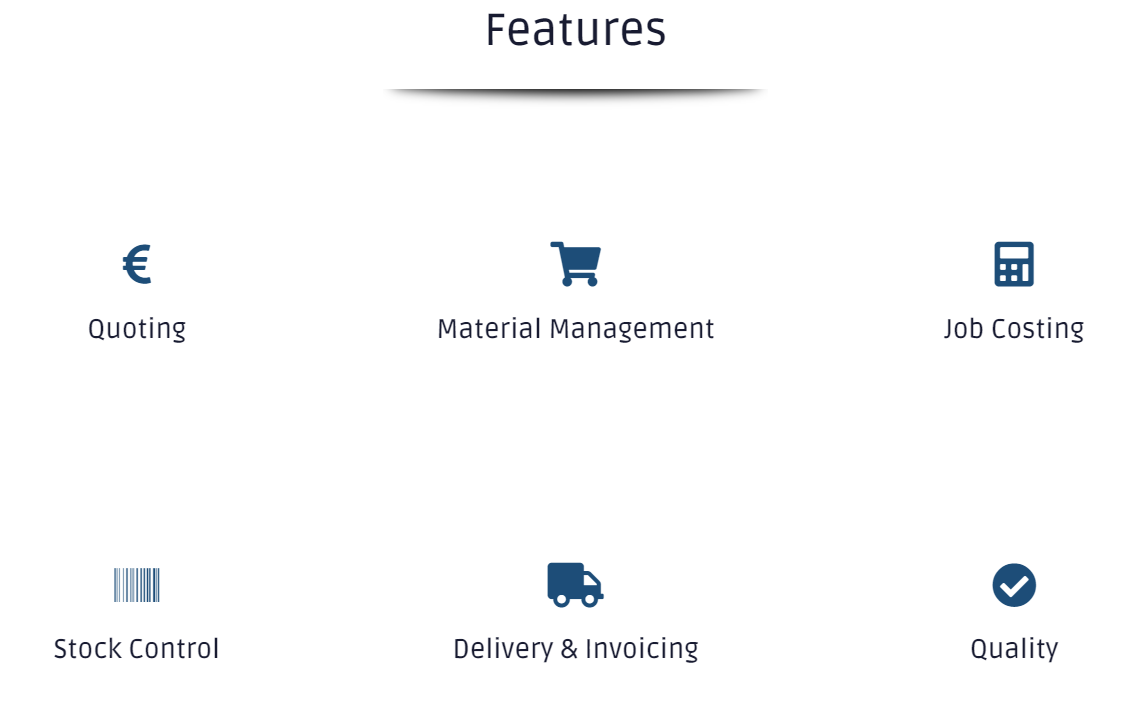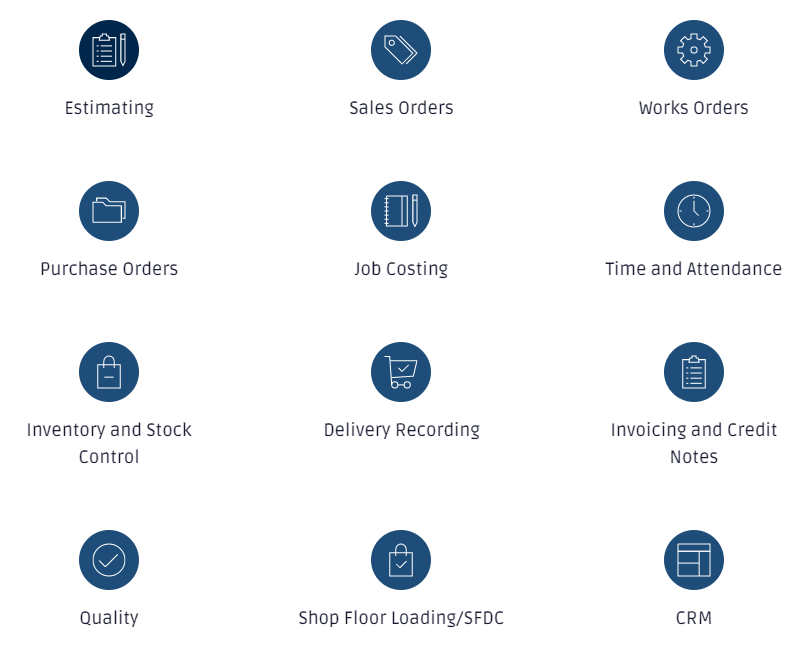From the manufacturing floor to the front office, production control software is a critical part of modern business.
It provides an efficient and organised way to track and manage the production process, from managing inventory and scheduling to monitoring quality assurance.
With its many features, it can help streamline production, reduce costs, and help your business stay competitive.
Moreover, it can help you identify issues before they become costly problems, making your business more efficient and profitable.
With our software, you have the power to take control of your production process and ensure that everything you produce meets the highest standards of quality and efficiency.
In this article, we will share our knowledge of Production Control Software – what it is and why your business may need it.
What is Production Control Software?
Production control software is software used to manage the production process. It can also be referred to as manufacturing execution systems, manufacturing execution tie-in systems, shop floor control systems, or manufacturing execution management software. It is used in automotive, aerospace, chemicals, food and beverage, pharmaceutical, and others. This software works on the concept of enterprise resource planning software. It is used for operations management and can integrate with other enterprise resource planning software to provide a 360-degree view of the business.
Many software providers develop production control software that can be integrated with ERP software. It has various features, such as real-time production tracking, product costing, quality management, supply chain management, and customer relationship management. It is mainly used to manage the manufacturing process and track inventory.
Benefits of Production Control Software
Production control software is the backbone of any manufacturing operation. It enables businesses to track and monitor the status of orders, supply chain activities, and inventory. It can also forecast future production requirements, identify potential issues, and suggest corrective actions. In addition, it can be used to track customer complaints, warranty claims, and product returns, which can help businesses improve their customer service and brand reputation. Moreover, the production control software can be a valuable tool for manufacturing and industrial organisations looking to optimise and streamline their production processes to improve efficiency, reduce waste, and increase profitability.
Let’s look at some of the benefits.
- Improved efficiency: It can help organisations streamline and automate their production processes, reducing the need for manual labour and the risk of errors. This can lead to increased efficiency and productivity.
- Better resource utilisation: It can help organisations plan and optimise the use of resources such as machines, labour, and materials to meet production goals. This can lead to better utilisation of resources and reduced waste.
- Increased profitability: It can help organisations reduce costs and increase profits by improving efficiency and resource utilisation.
- Enhanced data analysis and decision-making: It often includes data analysis and reporting tools, which can help organisations track and measure key performance indicators (KPIs) and make informed decisions about their production processes.
- Improved customer satisfaction: By helping organisations meet customer demand more effectively, production control software can increase customer satisfaction.
Features of Production Control Software
Production control software typically includes various features designed to help organisations manage and optimise their production processes. The specific features vary depending on the needs and goals of the organisation using it. It is vital for organisations to carefully evaluate their needs and consider the features that are most important for their production processes.
Some standard features includes:
- Production scheduling: This feature allows users to create and manage schedules for producing goods or services, considering available resources, customer demand, and capacity constraints.
- Material tracking: This feature helps users track and manage the flow of materials through the production process, including inventory levels, lead times, and supplier information.
- Machine scheduling: This feature allows users to schedule and optimise the use of machines and equipment in the production process, considering factors such as maintenance requirements and capacity constraints.
- Capacity planning: This feature helps users plan and optimise the use of resources such as machines, labour, and materials to meet production goals.
- Quality control: Many production systems include tools for monitoring and improving the quality of products or services, including features such as non-conformance tracking and corrective action management.
- Real-time visibility: It provides real-time visibility into production operations. Users can view the production cycle online and make necessary changes if necessary.
- Inventory management: This feature helps users track and manage inventory levels, including moving materials in and out of inventory.
- Cost management: It may include tools for tracking and analysing production costs, including materials, labour, and overhead.
- Real-time forecasting: It has forecasting functionality that allows businesses to forecast future production requirements.
- Remote access: It allows users to access the software remotely in real time.
Types of Production Control Software
There are mainly two types of production control software available: standalone and integrated production control software. Standalone production control software is an independent system that can be used with other systems. Integrated production control software is designed to work with other systems to provide a 360-degree view of the business.
Several types are designed to meet the needs of different organisations and industries.
Some common types include:
- Enterprise resource planning (ERP) software: This software includes a range of tools and features for managing and optimising production processes, as well as other business functions such as financial management, supply chain management, and customer relationship management. ERP software is suitable for larger organisations with complex production processes.
- Manufacturing execution systems (MES): This type of software is designed to support the execution of production processes in a manufacturing setting. It may include machine scheduling, material tracking, and quality control.
- Job shop software: This software is designed for small to medium-sized job shops that produce goods or services to customer specifications. It may include scheduling, material tracking, and cost management.
- Make-to-order software: This software is designed for manufacturers that produce goods or services to customer specifications on a made-to-order basis. It may include scheduling, material tracking, and capacity planning.
- Lean manufacturing software: This software is designed to support lean manufacturing principles, a philosophy focused on maximising value and minimising waste. It may include material tracking, machine scheduling, and capacity planning.
Overall, the specific type of production control software that is most suitable for an organisation will depend on the size and complexity of the organisation, the nature of its production processes, and its specific goals and needs.
How To Choose the Right Production Control Software?
With so many features and benefits, choosing the right production control software for your business can take time and effort. To help you make an informed decision, you should consider several factors.
- Identify your needs and goals: It is essential to carefully evaluate your organisation’s specific needs and goals and consider how production control software can help you meet those needs. This may include identifying particular challenges or bottlenecks in your production process that you hope to address with the software.
- Consider the size and complexity of your organisation: The size and complexity of your organisation will affect the type of production control software most suitable for you. For example, larger organisations with complex production processes may require more comprehensive ERP software. In comparison, smaller organisations with simpler production processes can use a more basic solution.
- Evaluate available features: Consider the specific features necessary for your organisation’s production process and ensure that the software you are considering includes those features. Some standard features of production control software include production scheduling, material tracking, machine scheduling, capacity planning, and quality control.
- Look for customisation options: It is often helpful to find production control software that can be customised to meet your organisation’s specific needs. This may include the ability to add or remove features or to integrate with other software or systems that you are using.
- Consider the vendor and support: Choose a software vendor with a good reputation and a track record of providing reliable support. It is also essential to consider the software’s level of support and training.
- Consider the cost: Make sure that the production control software you are considering fits within your budget. Be sure to compare the prices of different software options and consider any ongoing maintenance or support costs.
Production Control Software Implementation
The production control software has many benefits, and the most important among them is improved production efficiency. To get the most out of your software, you need to implement it in your organisation. This might sound logical, but many businesses must pay more attention to the implementation stage. Implementing production control software is a complex process that can take a few weeks to several months.
You need to keep a few things in mind while implementing production control software. Let’s take a look at them.
- Customer engagement – Customer engagement is the most important thing to remember while implementing it. You should keep your customers informed about the status of their orders, and you should also take their feedback. This will help you identify any future issues.
- Change management – You must manage the change process while implementing it. Change management is a critical function that helps you identify and mitigate risks.
- Human resources – You should also keep human resources in mind while implementing it. You should identify the resources required to implement the software and make the right changes in their job functions.
- Infrastructure – You should also keep the existing infrastructure in mind while implementing it. You must identify the IT infrastructure and make any necessary changes.
Implementing production control software can be complex and requires careful planning and execution.
Here are some steps that organisations can follow when implementing:
- Define your goals and objectives: Clearly define your goals and objectives for implementing it, including specific challenges or bottlenecks in your production process that you hope to address with the software.
- Evaluate potential software solutions: Carefully evaluate possible solutions based on your goals and objectives, and consider factors such as the size and complexity of your organisation, the specific features that you need, and the vendor and support options.
- Plan the implementation: Develop a detailed plan for implementing it, including tasks such as data migration, training, and testing. Make sure to involve key stakeholders in the planning process and consider any potential disruptions to your business that may occur during the implementation.
- Install and configure the software: Follow the vendor’s instructions for installing and configuring the software. This could include setting up user accounts, importing data, and configuring custom features or integrations.
- Train users: Provide training on how to use the software, including any new processes or procedures that will be implemented due to the software.
- Test and go live: Carefully test the software to ensure it is functioning as expected and that all data is accurate. Once testing is complete, go live with the software, making any necessary adjustments as needed.
- Monitor and maintain the software: Once the production control software is live, monitor its performance and make any necessary adjustments to ensure that it meets your goals and objectives. It is also essential to regularly maintain the software, including keeping it up to date with the latest version and addressing any issues that may arise.
It is essential to keep in mind that implementing production control software requires careful planning and attention to detail to ensure successful deployment and maximise the benefits of the software for your organisation.
Benefits of Production Control Software Implementation
Implementing production control software can be a valuable investment for manufacturing and industrial organisations looking to optimise and streamline their production processes to improve efficiency, reduce waste, and increase profitability.
It can also help you improve your customer service and identify the change in demand for your products.
There are several benefits that organisations can gain from implementing production control software:
- Improved efficiency: It can help organisations streamline and automate their production processes, reducing the need for manual labour and the risk of errors. This can lead to increased efficiency and productivity.
- Better resource utilisation: Itcan help organisations plan and optimise the use of resources such as machines, labour, and materials to meet production goals. This can lead to better utilisation of resources and reduced waste.
- Increased profitability: It can help organisations reduce costs and increase profits by improving efficiency and resource utilisation.
- Enhanced data analysis and decision-making: Itoften includes data analysis and reporting tools, which can help organisations track and measure key performance indicators (KPIs) and make informed decisions about their production processes.
- Improved customer satisfaction: By helping organisations meet customer demand more effectively, production control software can increase customer satisfaction.
- Enhanced collaboration and communication: It can help improve communication and cooperation between different teams and departments within an organisation, allowing for more seamless and efficient workflows.
Common challenges during production control software implementation
Implementing production control software can be a complex and time-consuming process that requires careful planning and attention to detail to ensure successful deployment and maximise the benefits of the software for the organisation.
Common challenges include resistance to change, lack of process maturity, and lack of resources. It is essential to address these challenges before implementing production control software in your organisation.
Let’s have a look at some of the common challenges in detail.
- Data migration: Migrating data from legacy systems or other software to the new production control software can be complex and time-consuming. It is essential to carefully plan and execute data migration to ensure that all data is accurate and complete.
- Training and adoption: It is essential to provide adequate training to users on how to use the production control software, including any new processes or procedures that will be implemented as a result of the software. Ensuring that users are comfortable and proficient with the software is key to successful adoption.
- Customisation and integration: Customising the software to meet an organisation’s specific needs and integrating it with other software or systems can be complex and may require specialised expertise. It is essential to carefully plan and execute customisation and integration to ensure that the software is functioning as expected.
- Change management: Implementing the software often requires changes to existing processes and procedures, which can be difficult for some users to adjust. It is essential to carefully plan and manage changes to minimise disruption to the organisation and ensure the smooth adoption of the software.
- Budget and cost management: Ensuring that the implementation of the software stays within budget can be a challenge, mainly if unexpected issues or costs arise. It is essential to plan and manage expenses carefully to ensure the implementation stays on track.
How to maintain production control software?
Maintaining production control software requires regular attention and effort to ensure that it continues to support the organisation’s needs and function optimally.
Maintaining production control software is vital to ensure that it continues to function optimally and support the organisation’s needs.
Here are some steps that organisations can take to maintain production control software:
- Keep the software up to date: It is important to regularly update it to ensure that it includes the latest features and is compatible with other software or systems the organisation uses. Updating the software can also help fix any issues or bugs that may have been identified.
- Monitor performance: Regularly monitor the performance of the software to ensure that it is functioning as expected and meeting the organisation’s needs. This may include tracking key performance indicators (KPIs) and analysing data to identify any areas for improvement.
- Address any issues or errors: If any problems or errors are identified with the software, it is vital to address them promptly to minimise disruption to the organisation. This could mean working with the software maker or a technical support team to find the problem and fix it.
- Conduct regular backups: Regularly backing up the data and configuration of the software can help protect against data loss or corruption in the event of an issue with the software.
- Train users: Provide ongoing training on how to use the software, including any new features or updates that are released. This can help ensure that users are proficient with the software and can take full advantage of its capabilities.
About Berkeley Myles
Berkeley Myles Solutions is a company that provides software solutions for manufacturing and industrial organisations to help them improve efficiency, reduce waste, and increase profitability.
Some of the software solutions offered by Berkeley Myles Solutions include:
ProgressPlus
ProgressPlus is a production control software designed to help organisations plan, schedule, and control their production processes. It includes inventory management, material tracking, machine scheduling, and capacity planning.
ProgressPlus can be used in various manufacturing and industrial settings, including job shops, make-to-order manufacturers, and assembly operations. It is designed to improve efficiency, reduce waste, and increase profitability by automating and streamlining production processes.
Some specific features of ProgressPlus include:
- Production scheduling: This feature allows users to create and manage schedules for producing goods or services, considering available resources, customer demand, and capacity constraints.
- Material tracking: This feature helps users track and manage the flow of materials through the production process, including inventory levels, lead times, and supplier information.
- Capacity planning: This feature helps users plan and optimise the use of resources such as machines, labour, and materials to meet production goals.
- Quality control: ProgressPlus includes tools for monitoring and improving the quality of products or services, including non-conformance tracking and corrective action management.
ProgressPlus is designed to help organisations effectively plan, execute, and monitor their production processes to meet customer demand and achieve their business goals.
This software enables businesses to manage their operations efficiently and cost-effectively. It can track and monitor all aspects of production, from raw material procurement to finished goods.
It is designed to help businesses streamline their processes, reduce costs, and increase productivity.
It can also help companies improve their products’ quality by providing real-time feedback on production processes and allowing them to identify and address any potential issues quickly.
Conclusion
Production control software is the backbone of any manufacturing operation. It is used to track and monitor the status of orders, supply chain activities, and inventory.
It can also forecast future production requirements, identify potential issues, and suggest corrective actions. With its wide range of features and benefits, production control software is essential for businesses of all sizes and industries.
We at Berkeley Myles understand the importance of having a reliable production control system. Our software provides an intuitive, user-friendly platform that makes managing inventory and production cycles easier.
Contact us for a bespoke demo if you want to learn more about our production control software and how it can help streamline your operations.



